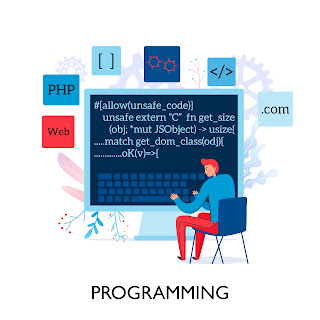Top 5 Programming Languages to Learn in 2025 for AI, Data Science & Web Development
Image by macrovector on Freepik
Abstract
As technology continues to evolve rapidly, the demand for programming expertise is at an all-time high. Choosing the right programming languages is key to career advancement in today's tech-driven world, from Artificial Intelligence and data science to web development. This guide explores the top 5 languages you should focus on, why they matter, and how they align with the current tech landscape.
Introduction: Why Programming Skills Matter in 2025
In the digital-first world of 2025, programming isn't just for software engineers. Coding has become a foundational skill—whether you're exploring Artificial Intelligence, working with data, or developing modern websites and applications. As AI tools become smarter and automation becomes widespread, developers must stay updated with the most effective and versatile languages.
This article highlights the top 5 programming languages to learn in 2025 based on industry trends, demand, learning curve, and versatility across AI, data science, and web development.
1. Python: The Powerhouse of AI and Data Science
Python remains the most popular and versatile language in 2025, especially for Artificial Intelligence, data science, automation, and backend development.
Why Learn Python?
Simple syntax ideal for beginners
Massive ecosystem of libraries (NumPy, Pandas, TensorFlow, Scikit-learn)
Widely used in AI model building, data preprocessing, and machine learning
Industry Usage: Google, Netflix, NASA, and many startups use Python for rapid development and research-driven projects.
2. JavaScript: The Language of the Web (and More)
JavaScript continues to dominate front-end web development. Over time, it has expanded into backend development with Node.js, mobile applications via React Native, and even into the realm of AI tools.
Why Learn JavaScript?
Essential for interactive websites and web apps
Ideal for full-stack development, thanks to popular frameworks such as React, Vue.js, and Angular
AI libraries like Brain.js are growing in popularity
Industry Usage: Used by almost every web platform including Facebook, YouTube, and Airbnb.
3. Java: Stable, Scalable, and AI-Ready
Java remains a go-to language in 2025 for large-scale applications, Android development, and enterprise-grade AI systems.
Why Learn Java?
Platform independence (Write Once, Run Anywhere)
Robust performance and scalability
Trusted in the development of AI and machine learning systems in enterprises
Industry Usage: IBM, Amazon, and LinkedIn use Java for enterprise and AI-based infrastructure.
4. R: Specialized for Statistics and Data Visualization
Although considered niche, R remains highly valuable in the data science and analytics fields, particularly for tasks involving statistical computing and advanced data visualization.
Why Learn R?
Excellent for complex statistical analysis and hypothesis testing
Packages like ggplot2, Shiny, and caret make data visualization easy
Preferred in academic and research environments
Industry Usage: Used by data analysts in finance, healthcare, and academia.
5. SQL: The Backbone of Data Handling
SQL remains essential for professionals who handle and manage data. Even in an age dominated by Artificial Intelligence, accessing and manipulating data efficiently is crucial.
Why Learn SQL?
Fundamental for database management
Used across all data-centric roles
Pairs well with Python and R in data science workflows
Industry Usage: Every tech company, from startups to enterprises, relies on SQL for storing, querying, and managing data.
Bonus Picks: Rust and Go
Rust offers memory safety and speed, making it ideal for performance-critical systems. Go (Golang) is great for scalable backend development and concurrency. Both are gaining traction in systems programming and cloud-native apps.
Summary: Choosing the Right Language for Your Goals
Each of these programming languages plays a vital role in real-world tech environments—whether powering AI models, building web applications, managing data, or scaling enterprise systems. Python leads for Artificial Intelligence and data science, JavaScript rules the web, and Java remains a backend and enterprise favorite. R and SQL offer niche but vital roles in analytics and data management.
The best choice depends on your career goals—whether you’re building smart AI apps, visualizing complex datasets, or launching web-based platforms.
FAQs
Q1: What is the most recommended programming language for Artificial Intelligence in 2025?
A: Python continues to be the leading choice, thanks to its extensive AI libraries, user-friendly syntax, and robust community support.
Q2: Should I learn more than one language?
A: Yes, combining Python with SQL or JavaScript provides a strong foundation across AI and web development.
Q3: Is Java still relevant for data science or AI?
A: Yes, Java is widely used in scalable AI systems, especially in enterprise environments.
Q4: Can I start learning these languages without a tech background?
A: Absolutely. Both Python and SQL are accessible to beginners, with a wide range of free online courses available to help you get started.
Conclusion: Stay Competitive in the Tech World
In 2025, learning to code is not just a smart move—it’s essential. With Artificial Intelligence integrated into every aspect of technology, the demand for skilled programmers is only rising. Mastering the right languages equips you with the power to build, analyze, and innovate in a rapidly evolving tech landscape.
Whether you're a student, a career-switcher, or a professional upskilling for the future, starting with these top 5 programming languages will prepare you for long-term success.
References
GitHub Octoverse 2024 Language Trends
Stack Overflow Developer Survey 2024
Coursera & edX Programming Course Statistics
IEEE Spectrum Top Programming Languages 2025
MIT Technology Review – Coding and AI Futures

.avif)

Comments
Post a Comment